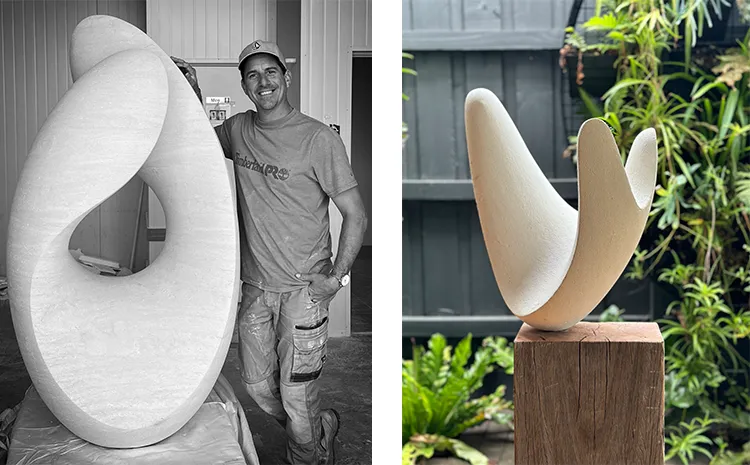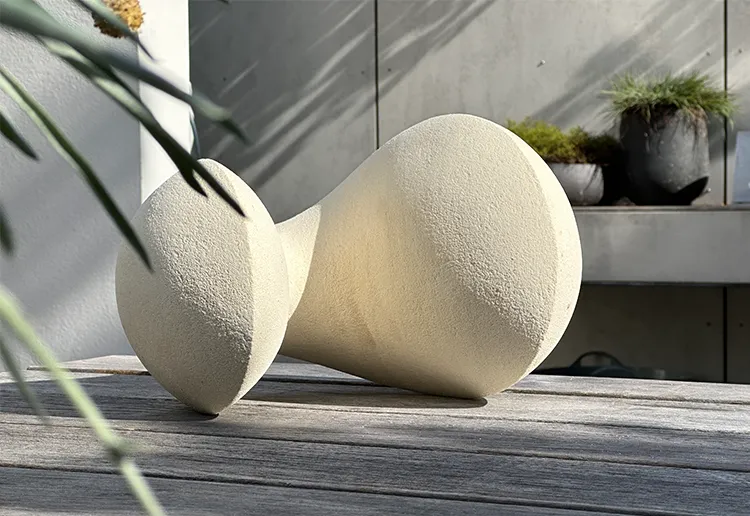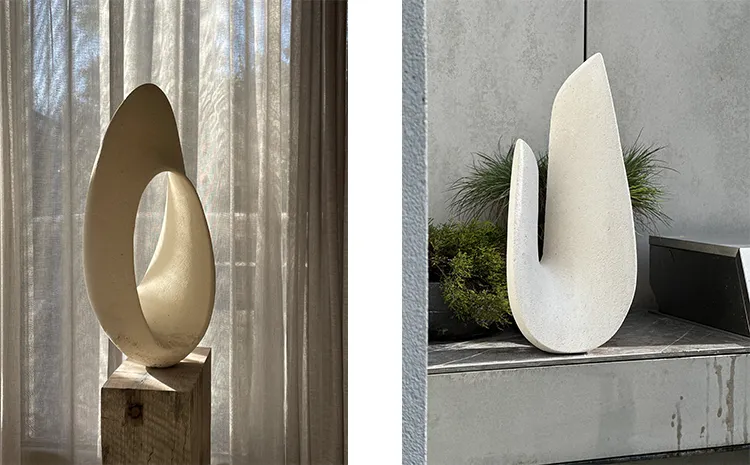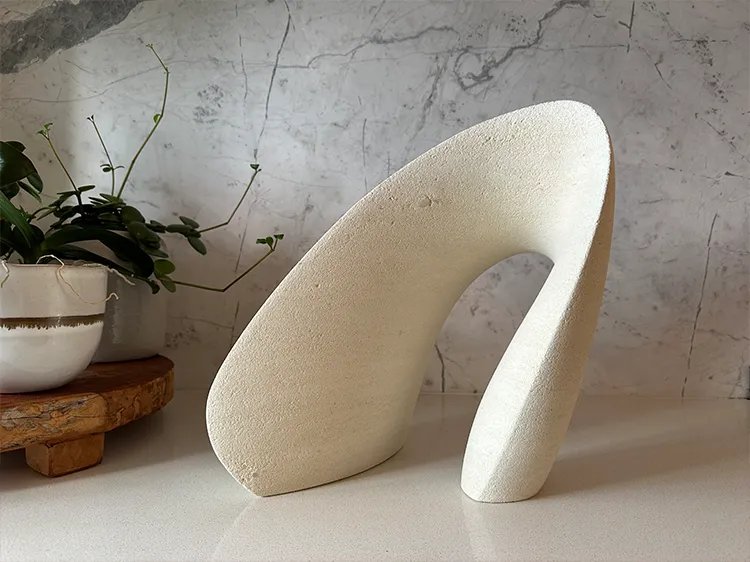“There is an overwhelming sense of freedom each time I step into the studio.”
From Africa to Artistry: A Journey of Creative Evolution
Dominic van der Merwe‘s journey into the world of art is a testament to the power of diverse cultural and familial influences. Born in South Africa, he moved to Australia at the tender age of six. His mother, a fashion designer, and his grandmother, a children’s book illustrator, instilled in him a deep appreciation for the arts from a young age. The aroma of Derwent pencils became a nostalgic scent of creativity in his childhood. Dominic’s early exposure to handcrafted objects in Africa, rich with texture and storytelling, significantly shaped his artistic sensibilities. His home is a sanctuary of artifacts and art pieces that celebrate natural materials, history, and a sense of place.
Dominic’s career in industrial design played a pivotal role in honing his ability to translate abstract ideas into tangible forms. This technical proficiency in capturing line and form laid a strong foundation for his later artistic endeavors. The transition from solving technical problems and producing consumer goods to embracing the freedom of artistic expression marked a significant turning point in his life. His work seeks to unveil deeper meanings and connections, celebrating the repeating patterns and archetypal forms that animate the universe.
Energy, in its various manifestations, is a central theme in Dominic’s art. From the spirals in DNA to the toroidal forces shaping galaxies, his sculptures strive to embody the intrinsic unity of reality. His art is a celebration of these fundamental patterns, a reflection of the universal forces that connect and animate all things. Through his work, Dominic aims to capture and celebrate the beauty and interconnectedness of the natural world.

Dominic van der Merwe: Crafting a New Artistic Identity
The inspiration behind Dominic van der Merwe’s artistic journey is rooted in his background as an industrial designer. Over the years, he developed a keen eye for observing the physical world and translating it into both two and three-dimensional forms. However, the constraints of industrial design often limited the pure joy of exploring form for its own sake. The shift to creating art allowed Dominic to pursue a deeper, more intrinsic form of expression, unbounded by external briefs or purposes beyond the form itself.
Stepping into the studio, Dominic experiences a profound sense of freedom. His art is an exploration of the patterns and poetry inherent in nature, providing him with insights into life and, by extension, himself. This newfound passion for capturing the essence of life’s energy in his work reflects a journey of self-discovery and artistic liberation. The transition from industrial design to art has enabled him to delve into the deeper, more meaningful aspects of form and movement.
Dominic’s fascination with universal ideas permeates his art. Drawing inspiration from quantum physics, cosmology, biology, poetry, history, and music, he seeks to uncover the underlying concepts and patterns that connect all things across different scales. His work reflects the dynamic, fluid nature of life, capturing the movement of energy as it manifests in the physical world. Whether it’s the arc of a wave, the unfolding of a petal, or the way water carves stone over time, Dominic’s art seeks to embody the poetry of nature’s curves and surfaces.

The Artistic Alchemy of the Studio
Dominic van der Merwe’s workspace is a testament to the transformative power of creativity. His concrete basement studio, though modest and utilitarian, serves as a sanctuary where time and distractions fade away. The tarps controlling dust, the background music, and thought-provoking podcasts create an environment that allows Dominic to enter a state of creative flow. The compression of space and the immersive nature of his work enable him to transcend the limitations of his physical surroundings.
Despite the unglamorous setting, Dominic’s studio is a crucible of artistic experimentation. Here, he brings his visions to life, exploring the tactile qualities of different materials and the possibilities they offer. His ability to focus and immerse himself in the creative process allows him to push the boundaries of his artistic expression. The constraints of his workspace do not hinder his creativity but rather fuel it, driving him to innovate and adapt.
Dominic’s future aspirations include working in more natural and expansive environments, where he can draw inspiration directly from the world around him. However, for now, his basement studio remains a vital part of his artistic journey. The interplay between the constraints of his current space and the boundless potential of his creativity continues to shape his work in profound ways. His studio is not just a physical space but a reflection of his artistic process and the ever-evolving nature of his craft.

Dominic van der Merwe: Influences and Inspirations
Dominic van der Merwe’s artistic journey is deeply influenced by the works of renowned sculptors Henry Moore and Barbara Hepworth. Although he did not formally study their work, he feels a strong affinity for their pieces and finds a shared essence in their artistic explorations. This connection to his artistic predecessors provides a sense of continuity and inspiration as he carves out his own path in the art world.
One of Dominic’s most significant pieces is “Acquiesce,” a sculpture that encapsulates the heart-wrenching turmoil of global conflicts. This work is an expression of the pain and frustration of facing seemingly insurmountable challenges. The piece captures a moment of reluctant acceptance, where surrender leads to a profound inner peace. This peace, Dominic believes, holds the true power to effect change in the world. “Acquiesce” is a poignant reminder of the resilience of the human spirit and the transformative power of art.
Dominic’s choice of medium is often serendipitous, as exemplified by his discovery of limestone carving at the Melbourne International Flower and Garden Show. The soft, malleable nature of limestone allowed him to quickly explore and develop his ideas, fostering a rapid evolution of his artistic style. As he continues to experiment with different materials, including bronze, stone, steel, and polymer, he remains open to new possibilities and techniques. His industrial design background provides him with the technical skills to digitize his art, further expanding his creative horizons.





